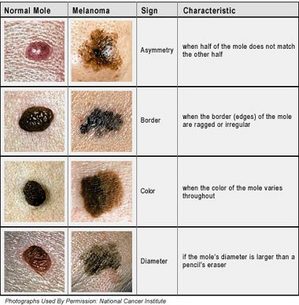Use this mole chart as a handy reference to check your skin if you have an increased risk for melanoma:
- Fair skin
- A history of sunburn
- Excessive ultraviolet (UV) light exposure
- Living closer to the equator or at a higher elevation
- Having many moles or unusual moles
- A family history of melanoma
- Weakened immune system
Moles are unusual growths on the skin, which occur when melanocytes (pigment producing cells) grow in a cluster with surrounding skin tissue. Moles are common and the majority are harmless, however those with an unusual appearance (dysplastic nevi) have a greater chance of developing into melanoma, a type of skin cancer.
Experts recommend that if you are at increased risk for melanoma that you check skin once a month. It’s suggested that you contact a dermatologist if you discover a mole that itches, bleeds or exhibits changes. If a mole has variations in color from one area of the mole to another or is larger than the size of a pencil eraser it should be checked by a dermatologist.



